Android Central Verdict
The Garmin Forerunner 265 is undoubtedly one of the best running watches available today, improving on the recent 255 with a more readable AMOLED display and two key software tools: the useful Training Readiness metric and wrist-based running form analysis. You'll need the premium Forerunner 965 to take full advantage of the new display tech, but this more affordable and compact model has almost anything else an athlete needs (except more mainstream hardware like a mic/speaker or third-party apps).
Pros
- +
Vibrant AMOLED display is more readable than ever
- +
Adds touchscreen, training readiness, running dynamics
- +
Garmin is still best for tracking accuracy
- +
Comes with USB-C charging cable
- +
265S option is more comfortable, longer-lasting
Cons
- -
Shorter battery life than Forerunner 255
- -
No topographical maps, real-time stamina
- -
Design could use an update
Why you can trust Android Central
One day, I'd like to ask Garmin's engineers how they release so many watches in rapid succession. As to how the Garmin Forerunner 265 shipped less than a year after its predecessor, though, the answer is obvious: they slapped a new AMOLED coat of paint on the Forerunner 255 display, added a couple of new features so no one would get suspicious, and changed the number.
I'm being both reductive and facetious, but the point stands that the Forerunner 265 is an iterative upgrade made to address Garmin users' frustration with memory-in-pixel displays — not because the Forerunner 255 is suddenly obsolete.
So aside from a couple of cool new perks pinched from the Forerunner 955, the Forerunner 265 isn't a revolutionary release. It doesn't have to be, with a solid 255 foundation to build upon.
Instead, the Forerunner 265 is an odd hybrid between a Forerunner and Venu, without the lifestyle perks like a mic and speaker that the latter usually has. It's a niche that the Forerunner 965 fills better because it uses its AMOLED display for full-color mapping, whereas the 265 doesn't have any "killer apps" to justify it; you're paying extra for readability and looks.
For some people, that's more than enough reason to buy the Garmin Forerunner 265, even at such a high price. Let's dive in and see if you're one of them.
Garmin Forerunner 265 price and availability

The Garmin Forerunner 265 and 265S both retail for $449.99. That's $50 more than the Forerunner 255 Music, $50 less than the Forerunner 955, and $150 less than the Forerunner 965. Unlike the 255, the Forerunner 265 comes with music storage by default.
You'll find both Forerunner 265 models on Garmin's site and a few outdoor retailers like REI and Backcountry; they're not on electronic retailers like Amazon or Best Buy yet, but they likely will be later in 2023.
Both the 46mm 265 and 42mm 265s come in three finishes. The Forerunner 265 comes in Whitestone with White/ Tidal Blue band; Black with Black/ Powder Gray band; and Aqua with Black/ Aqua band.
The Forerunner 265S ships in Black with Black/ Amp Yellow band; Whitestone with White / New Tropic green band; and Pink with Light Pink/ Whitestone band.
AMOLED display
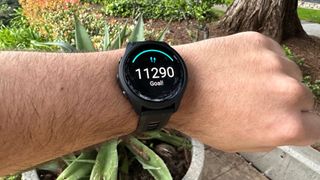
Anyone considering buying the Garmin Forerunner 265 after skipping (or owning) the Forerunner 255 has one reason for doing so: the AMOLED display. Because otherwise, these two watches barely differ from one another. So let's not waste any time and talk about that new display!
Garmin gave the Forerunner 265 the same display as the Venu 2 Plus: a 1.3-inch touchscreen with 416 x 416 resolution. Both watches easily combat direct sunlight with bright, dense text and vivid colors. For example, when you swipe onto a widget, you'll see a neat sliding gradient effect that matches the widget's color — and it's very satisfying and accessible for the visually impaired.
While the 260 x 260 Forerunner 255 display looks bright enough outside, I noted in my review that memory-in-pixel (MIP) displays "remain fairly dim indoors in low light." That, combined with the low pixel-per-inch (PPI) density, means you have to bring the watch closer to your face to comfortably read notifications since the text itself is dull and a little blurry around the edges.
Anyone upgrading from an older Forerunner model will appreciate the 265's more vibrant watch faces and its ability to pack information into smaller fields without losing any crispness.
The Garmin Forerunner 265 AMOLED display is an optional upgrade since it doesn't add new functionality over the 255, but runners with poor eyesight will have trouble going back to MIP displays.
Plus, of course, you get the benefit of a touchscreen. While it's pretty superfluous during runs — sweaty fingertips and touch displays never mix well, and you have to manually enable touch for specific activities — I do appreciate the option during regular watch navigation, as the Up and Down buttons remain as squishy and slow to use as ever.
If the Forerunner 265 display has a noticeable flaw, it's the refresh rate: you may notice an occasional stutter when scrolling through content or watching an animated exercise. But I suspect this is more to do with a budget processing chip than the display itself. It's the only way fitness brands can make their watches last for weeks.
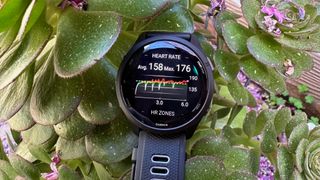
My other complaint is that Garmin only gave this watch Gorilla Glass 3. The Forerunner 955 and 965 each get GG 3 DX, which gives you better anti-reflective glass. But I'd even prefer that, at this price, you get proper sapphire glass protection, or at least the more scratch-resistant GG DX+. If you're paying extra for an AMOLED, it'd be nice to have more peace of mind that it'll stay scratch-free.
I'll spoil the Software section below a bit: Garmin doesn't use its AMOLED display for anything new that an MIP can't do. You'll need to buy the Garmin Forerunner 965 to get its full mapping software, which looks fantastic on an AMOLED compared to the Forerunner 955 MIP.
The extra $100 you'd spend over the Forerunner 255 is for an "optional" upgrade, at least in its capacity as a running watch. But it's certainly a major visual improvement for day-to-day use, and it's difficult to think about going back to an MIP-era Forerunner after my eyes have gotten spoiled with this AMOLED.
Design and hardware
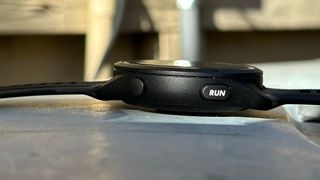
Without turning on the displays, you'd be hard-pressed to tell the Garmin Forerunner 265 and 255 apart. Both have that signature Garmin look: Plastic bezels and casing for a uniform, rugged look, a silicone strap, and a five-button layout.
The differences are subtle. Both the top-right button and end of the silicone strap have the word "RUN" embedded, which is a cute touch. I care more that the 265 RUN button — which starts or pauses workouts or selects menu items — is wider than before, with room for your index finger to rest and a more satisfying click.
As for the other four buttons, they're fairly squishy, a complaint I had with the 255. On that watch, the buttons have a metallic sheen that makes them stand out; the 265 buttons have a more matte finish that blends into the case more uniformly, which you may or may not prefer.
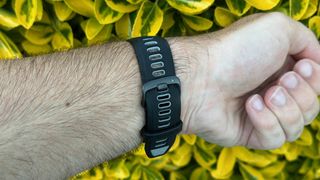
You'll also find this generation's two-toned silicone straps more stylish than before. The secondary color peeks through the band's lug holes for a bit of extra personality. And although I can't quite articulate why, I find this band slightly more comfortable than the last generations' bands. Maybe it's a bit softer.
Still, you're buying the Garmin Forerunner 265 for a display upgrade, not a design upgrade. Nearly every watch in the $400-and-up category uses aluminum or titanium, making Garmin's addiction to "fiber-reinforced polymer" on high-end models a bit unfortunate. But long-time Garmin users probably don't care about a svelte look, since only hybrid or budget models like the vívomove Trend are especially stylish.

If you're not used to Garmin watches, keep in mind that they're generally thick and heavy, in order to pack in a hefty battery and full sensor suite. The Forerunner 265 is no different. At 12.9mm thick, it's noticeably thinner than the Forerunner 955 (14.4mm) or COROS APEX 2 (14.6mm); but if you're used to something like an 11mm Apple Watch, you probably won't like the fit.
I find the Forerunner 265 comfortable for running, but I do notice it on my wrist after a long workday; when I take it off in the evening, I'll find the sensor suite has usually left a red circular indent in my skin. That's not abnormal, but other watches have a wider sensor that puts less pressure on one spot; Garmin has to leave room for its charging port next to the sensors, and that affects the comfort level.
Garmin calls this watch the "Forerunner 265 Large" in the Garmin Connect app, and it's an apt name. I love the large display, but if I were buying it for myself, I'd strongly consider the 1.1-inch Forerunner 265S.
It weighs 8g/ 0.3oz less than the Forerunner 265, making the 265S more comfortable for daily wear. Whereas the Forerunner 255S' petite MIP display was a real trade-off, the 265S' pixel-rich AMOLED handles small text far better, so the visual downgrade isn't nearly as pronounced.
Plus, because AMOLEDs consume so much battery life, the smaller Forerunner 265S actually lasts longer than the 265, which is pretty rare for watches that cater to smaller wrists.
| Category | Garmin Forerunner 265 (and 265S) |
|---|---|
| Materials | Fiber-reinforced polymer |
| Display | 1.3-inch (416 x 416) or 1.1-inch (360 x 360) AMOLED display |
| Bands | 22mm or 18mm (industry-standard) |
| Dimensions | 46.1 x 46.1 x 12.9mm (265); 41.7 x 41.7 x 12.9mm (265S) |
| Weight | 47g (265); 39g (265S) |
| Protection | 5ATM; Gorilla Glass 3 |
| Sensors | GPS, GLONASS, GALILEO, HRM, barometric altimeter, compass, gyroscope, accelerometer, thermometer, ambient light sensor, SpO2 |
| Connectivity | Garmin Pay, Bluetooth, ANT+, Wi-Fi |
| Music Storage | 8GB |
| Colors | Whitestone, Black, Aqua (265), Pink (265S) |
Both the Forerunner 265 and 255 pack an identical, comprehensive suite of tools that runners need: the three main GNSS options, an altimeter for proper elevation and effort measurement, a compass for rudimentary navigation tools, the same Elevate v4 heart rate sensor that we've found highly accurate in previous reviews, and blood oxygen tracking for improved sleep data.
I also appreciate getting both an accelerometer and gyroscope, since the latter often isn't included in running watches. Together, they're useful for more accurate cross-training data with activities like swimming or HIIT.
Plus, you get direct Wi-Fi downloads instead of relying on Bluetooth and your phone to upload activity data or download updates, as well as NFC tap-to-pay.
Its 8GB of storage for watch faces and music is double what the 255 Music had, so you can squeeze in hundreds more songs. I use my own music files uploaded via Garmin Express, but you can add playlists through Spotify, Deezer, or Amazon Music.
What's missing in terms of Garmin Forerunner 265 hardware? Pretty much everything you'd get with the Garmin Venu 2 Plus. You won't find an ECG app for AFib detection, nor a mic and speaker for answering phone calls and speaking to your connected phone assistant. The Forerunner 265 puts more emphasis on fitness than on being a smartwatch.
Nor does Garmin have any LTE upgrade option. You'll have to step back to the Forerunner 945 LTE to safely leave your phone behind.
Battery life and GPS accuracy
As I mentioned above, the Garmin Forerunner 265 falls slightly short of the 265S in terms of battery life — and neither match the Forerunner 255. Both are well above average for AMOLED watches, ignoring Amazfit and COROS watches as the long-lived exceptions. But you do have to accept the inevitable trade-off that comes with abandoning the dim, economical MIP display.
| Battery mode | Garmin Forerunner 265 | Garmin Forerunner 265S |
|---|---|---|
| Smartwatch mode | 13 days | 15 days |
| GPS only | 20 hours | 24 hours |
| Auto-select GNSS (SatIQ) | 16 hours | 18 hours |
| All-Systems GNSS + Multi-Band | 14 hours | 15 hours |
| GPS with music | 7 hours | 7 hours |
| All-Systems GNSS + Multi-Band with music | 6 hours | 6 hours |
The default SatIQ setting is what most people will use, so keep those numbers in mind. It can "determine when Multiband GNSS is needed, like near tall buildings or in a dense forest, or when a low power GPS mode can achieve the same accuracy, like in more open areas," as Garmin describes it.
SatIQ seems to work as intended for obstacle-heavy runs, though I have no way of testing how often it switches from one satellite feature to the next. But I also quickly decided to switch to the most accurate setting (all GNSS systems plus dual-frequency GPS) because it only uses two extra hours of battery.
The combination of its gorgeous AMOLED display and ultra-accurate multi-band tracking makes the Forerunner 265 more middle-of-the-road (though still good) for battery life.
GPS-only tracking gives you a mostly accurate distance-to-effort ratio, but your maps frequently show you drifting into traffic or natural obstacles, and these discrepancies can lead to inaccurate mile times. Even with multiple GNSSs or dual-frequency active, some fitness watches fail to track properly.
With Multi-Band active, I ran three mile-long loops around my neighborhood, taking care to run on different sides of the sidewalk or in the street at specific points to see if my Forerunner 265 could accurately follow my position.
Thankfully, the Garmin Forerunner 265 proved to be just as accurate as the 255 and 955 — which is to say, extremely accurate. It almost always shows my actual path around street-hogging dog walkers and into the road around bad drivers making rolling stops, lines staying consistent even under dense tree cover.
The only problem is, if you finish a few hours of dual-frequency GPS-tracked runs a week as I did, in addition to continuous heart rate tracking and checking notifications, you're going to fall well short of the 13-day estimate. A week is more likely, give or take a day, depending on how active you are.
For me, that's long enough that I won't get annoyed by the frequency. Especially because Garmin included a USB-C charging cable with the Forerunner 265, which speeds up the recharge time so you won't be kept waiting too long. But if you're used to a watch like the Garmin Instinct 2 Solar or COROS APEX 2 Pro with a month-long battery, then an AMOLED display may not be the right choice for you.
Features and software
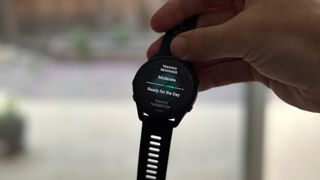
Succinctly covering every software tool in a Garmin watch is a fool's errand. If you're unfamiliar with Garmin software, suffice it to say that the Forerunner 265 has all the features you'd need to hold your hand on your couch-to-5K journey or to hit a PR in a half marathon.
If you are familiar with Garmin software, then there's no point harping on long-time tools like daily suggested workouts, Garmin Coach, recovery time, Body Battery, acute load, Pacepro, VO2 Max, and race time predictions that you're already familiar with.
In essence, the Forerunner 265 tells you how in shape you are, how hard to run on a given day, measures your training effort and effect after a run, tells you how long you need to recover, and uses your sleep, stress, and heart rate variance (HRV) scores to determine how much energy you've recovered.
Training Readiness and on-wrist Running Dynamics are the two main "exclusives" for the Forerunner 265, but I suspect the 255 will get TR eventually, and RD is a niche feature.
With that preamble out of the way, I'll focus on what's new (and what's missing). The biggest addition is Training Readiness, a revamped version of Body Battery that not only factors in sleep, stress, and HRV but also includes your acute load and recovery time data. It fixes the problem of your Body Battery showing you full of energy for a workout when your muscles aren't ready for what your heart can handle.
As I said when I reviewed the 955, training readiness is "helpful and intuitive," with a simple score that should reaffirm how your body is feeling and push you back out onto the street when you're ready.

You also get wrist-based running dynamics, meaning you can see your cadence (steps per minute), stride length, and vertical ratio/ oscillation (how high and for how long you push above the ground). Normally, you need the $80 Running Dynamics Pod accessory or a more expensive heart rate monitor strap like the Garmin HRM-Pro Plus with the same tech.
I compared my wrist-based Running Dynamics scores to the more reliable Pod data and found them to be in the same ballpark, but not exactly the same. And it doesn't register ground contact time balance between your left and right foot, which you get with the Pod.
While I appreciate having running form info without having to worry about accidentally washing the Pod with my shorts (yes, I've done this before), I also never really know what to do with this data. I know both my average cadence and stride length are below what online running guides recommend, but I also know that trying to actively change your running form without direct coaching can lead to injury and take you out of the zone. So while you may find this data useful, I mostly ignore it and focus on improving my overall stamina.
I suspect Garmin may bring training readiness to the Forerunner 255 eventually since it has HRV data and all the other tools needed to calculate it; plus, Garmin does tend to support its older watches after launch with newer software. So upgrading to the 265 will have limited returns unless you care about running dynamics.
That being said, anyone with an older Forerunner or a non-Garmin watch should have very few complaints. And the AMOLED display does augment some old features: I much prefer doing HIIT workouts on the 265, simply because the animated exercise guides look so much better and are easier to follow.
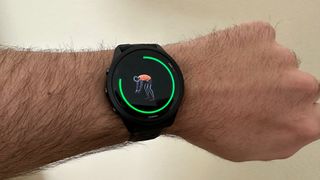
The main features you gain from the Forerunner 965 over the 265 are topographical maps, ClimbPro, and real-time stamina. I did like seeing Garmin's estimates during a run for how many miles my body could still handle, so that's one reason to upgrade. And while I rarely run in areas where I'd get lost, runners who need tools like round-trip routing won't be satisfied with the 265's basic line-on-a-blank-screen maps.
I also wish the Forerunner 265 had more watch faces that take advantage of its best tools; the 955 lets you see your training status or acute load without having to scroll through menus, whereas I can't find those data fields on Forerunner 265 watch faces. But that's a minor complaint.
Competition
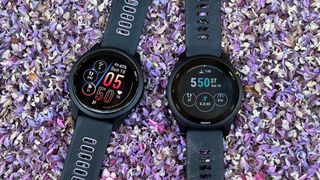
If you don't care about music storage or an AMOLED display, then you can buy the Garmin Forerunner 255 for $100 less and receive 90% of the same software and much better battery life. $350 is already at the upper end of what some runners will want to pay, so you shouldn't feel pressured to upsell yourself to the 265 if you can't afford it and you're used to memory-in-pixel displays.
Since I haven't reviewed the Forerunner 965 yet, I can't judge it as a "rival" completely. But like the 955, it's heavier and thicker on your wrist, with a 1.4-inch display that's less pixel-dense at 454 x 454. You'll appreciate the titanium case and 10 extra days of battery life, not to mention those tempting topographical maps. But its price takes you into Fenix territory, which is just too much for most runners.
Among the best running watches not made by Garmin, you'll want to look into COROS and Polar. Both brands have a similar Garmin ethos with free running training software and long-lasting batteries, but neither has made the switch to AMOLED displays yet.

If you want a fitness-focused watch that actually uses its AMOLED display to full effect, you may want to look into one of the big two wearable brands: Apple or Samsung.
The Apple Watch has added a ton of useful running data since watchOS 9, including heart rate zones, mapped routes, custom workouts, running power, form metrics like cadence and stride length, and so on. You can subscribe to Fitness+ for cross-training, but it's optional. The main downside is the need for daily charges and just 7 hours max of GPS data.
Android users should consider the Galaxy Watch 5 Pro, which matches the Forerunner 265 with 20 hours of GPS tracking and the same $450 price tag. It uses its Exynos chip and Wear OS 3 software for a much smoother and more useful interface outside of running. Much heavier and thicker than Garmin's watch, the Pro doesn't have the same running tools in Samsung Health, so you'll have to rely on third-party Wear apps or just be more self-guided in your workouts. But you can download GPX maps.
Garmin Forerunner 265: Should you buy it?

You should buy this if...
- You're a serious runner who cares more about coaching and guidance than third-party apps.
- You want Forerunner-quality software with a Venu-quality display.
- You need the best-possible accuracy for heart rate and GPS tracking data.
You shouldn't buy this if...
- You want to take full advantage of an AMOLED display with maps or apps.
- You want the best possible battery life.
- You're on a tight budget.
While I love the Garmin Venu 2 Plus as an all-around fitness smartwatch, it's difficult for me to enjoy using it now that I've gotten accustomed to Forerunner software, with all the perks and guidance that it gives runners.
The Garmin Forerunner 265 is the closest I've seen to a proper melding between the two, thanks to the AMOLED display. I wouldn't be surprised if a future 275 or 975 added a mic and speaker for a more complete device. I'm worried about how much such a device would cost, but that's a hypothetical to worry about later.
For now, many of my favorite Garmin devices — the Venu 2 Plus, Instinct 2 Solar, and Forerunner 265 — all hit this same $450 price point while targeting different types of athletes. While the Forerunner 255 is the better bargain, the 265 is far more accessible than headache-inducing MIP displays for regular use.
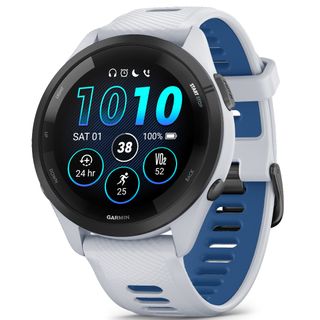
Like the 255, the Forerunner 265 has nearly the full Garmin runner's toolbox to help you to decide when to push hard or rest, measuring everything from sleep and heart health to your running form and likely race times. And while it's mostly a superficial update, the AMOLED touch display just makes the watch more enjoyable to use.

Michael is Android Central's resident expert on fitness tech and wearables, with an enthusiast's love of VR tech on the side. After years freelancing for Techradar, Wareable, Windows Central, Digital Trends, and other sites on a variety of tech topics, AC has given him the chance to really dive into the topics he's passionate about. He's also a semi-reformed Apple-to-Android user who loves D&D, Star Wars, and Lord of the Rings.
For wearables, Michael has tested dozens of smartwatches from Garmin, Fitbit, Samsung, Apple, COROS, Polar, Amazfit, and other brands, and will always focus on recommending the best product over the best brand. He's also completed marathons like NYC, SF, Marine Corps, Big Sur, and California International — though he's still trying to break that 4-hour barrier.

